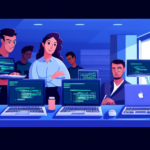“`html
From Cloud to Edge: How These Technologies Are Reshaping Innovation
In recent years, cloud computing and edge computing have emerged as pivotal forces in the digital transformation of industries worldwide. These technologies have not only revolutionized how businesses operate but also opened up new possibilities for innovation. This article explores the evolution, benefits, and challenges of cloud and edge computing, highlighting their synergistic relationship and the profound impact they are having on various sectors.
Understanding Cloud Computing
Cloud computing refers to the delivery of computing services—such as servers, storage, databases, networking, software, and intelligence—over the internet (“the cloud”). It enables users to access these resources on-demand, scaling up or down as needed. The core principles of cloud computing include agility, scalability, and cost-effectiveness. By leveraging cloud services, organizations can reduce capital expenditure on hardware and infrastructure while improving operational efficiency.
One of the most significant benefits of cloud computing is its ability to provide scalable solutions. For instance, healthcare providers can use cloud platforms to store and manage patient data securely, ensuring compliance with regulations while maintaining accessibility for authorized personnel. Similarly, financial institutions rely on cloud-based systems to process transactions, perform risk assessments, and ensure data integrity. Retailers, too, have embraced cloud technology to enhance customer experiences through personalized recommendations and seamless online shopping experiences.
Understanding Edge Computing
Edge computing involves processing data closer to the source of generation, rather than sending it back to a centralized data center or cloud. This approach significantly reduces latency, which is crucial for applications requiring real-time processing. Unlike cloud computing, which centralizes data processing, edge computing decentralizes it, bringing computational power closer to the end-user or device.
Edge computing addresses several limitations of traditional cloud architectures. For example, in autonomous vehicle systems, every millisecond counts when making critical decisions based on sensor data. Sending all this information to a remote server would introduce unacceptable delays. Instead, edge computing processes the data locally, allowing vehicles to react instantaneously to their environment. Similar benefits are realized in smart city initiatives, where edge devices analyze traffic patterns, optimize energy usage, and enhance public safety in real-time.
The Synergy Between Cloud and Edge Computing
While cloud and edge computing serve different purposes, they are increasingly being integrated into hybrid systems that leverage the strengths of both approaches. This synergy allows organizations to achieve optimal performance, cost-efficiency, and reliability. Hybrid architectures typically involve deploying edge nodes at the periphery of networks to handle local processing tasks, while cloud environments manage more complex analytics, long-term storage, and cross-device coordination.
A prime example of this synergy is found in the Internet of Things (IoT). Many IoT devices generate vast amounts of data that need immediate analysis for actionable insights. By offloading some processing to edge nodes, these devices can respond quickly to changing conditions without overwhelming centralized cloud infrastructure. Meanwhile, cloud services continue to provide robust backend support for data aggregation, machine learning model training, and long-term trend analysis.
Challenges and Considerations
Despite the numerous advantages offered by edge computing, there are several challenges that must be addressed to ensure successful implementation. Security remains a primary concern, especially given the distributed nature of edge networks. Ensuring data privacy and protecting against unauthorized access require robust encryption protocols and secure communication channels.
Interoperability is another challenge faced by organizations adopting edge computing. Different devices and systems may use varying standards and protocols, complicating efforts to integrate them seamlessly. To overcome these hurdles, industry standards and open-source frameworks are essential for promoting compatibility and facilitating collaboration among stakeholders.
Looking ahead, the future of cloud-edge ecosystems promises even greater advancements. As technology continues to evolve, we can expect increased automation, enhanced analytics capabilities, and more sophisticated integration tools. These developments will further accelerate innovation across diverse industries, creating new opportunities for growth and competitiveness.
Conclusion
In conclusion, cloud and edge computing represent powerful tools for driving innovation in today’s fast-paced digital landscape. By understanding the unique strengths and complementary roles of each technology, organizations can harness their full potential to create smarter, more efficient solutions. Whether it’s optimizing supply chains, enhancing customer experiences, or advancing scientific research, the combination of cloud and edge computing offers limitless possibilities.
As we move forward, staying informed about emerging trends and best practices will be crucial for maximizing the benefits of these technologies. With continued investment in research and development, we can look forward to even more transformative applications in the years to come.
Final Thoughts
If you’re intrigued by the potential of cloud and edge computing, consider exploring additional resources or conducting your own research. There are countless articles, whitepapers, and case studies available that delve deeper into specific aspects of these technologies. Additionally, many industry conferences and webinars offer valuable insights from experts in the field.
For businesses and individuals looking to capitalize on these innovations, now is an ideal time to start exploring how cloud and edge computing can be integrated into existing operations. Whether you’re seeking improved operational efficiencies or groundbreaking new products and services, the possibilities are endless.
“`


